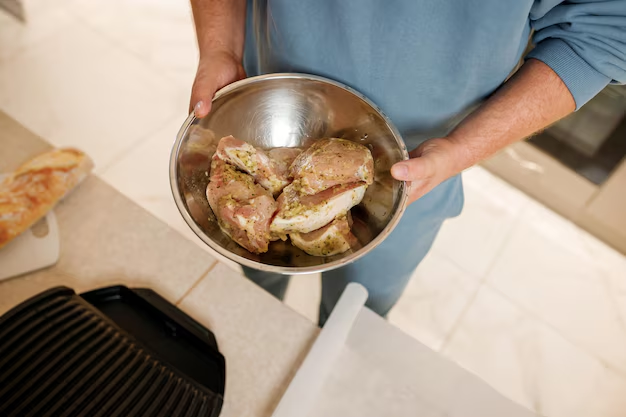Can You Put Hot Chicken in the Refrigerator? Here's What You Need to Know
Ever finished a delicious chicken dinner, only to wonder if you can safely store any leftover hot chicken in the refrigerator? While it might seem like a simple question, it's actually a topic filled with varying opinions, some culinary folklore, and a lot of science. In this article, we’ll delve into the ins-and-outs of refrigerating hot chicken, and explore the broader context of food safety and storage to empower you with the know-how you need.
🕵️♂️ What’s the Debate? The Basics of Cooling Down Chicken
Before diving into whether placing hot chicken directly into the refrigerator is a go or no-go, it's essential to understand the underlying concerns:
- Temperature: Rapid temperature changes can affect food quality.
- Moisture: Condensation might alter the texture of your food.
- Bacteria Growth: The fear of bacteria multiplying in the so-called "danger zone."
The main concern is that placing a hot item in the refrigerator might raise the internal temperature of the appliance, allowing bacteria to thrive both on your chicken and in other foods stored there. However, contemporary advice offers some clarity.
🧑🍳 To Chill or Not to Chill: Expert Consensus
The Argument for Cooling First
Traditionally, many thought it best to let food cool to room temperature before refrigerating, primarily because:
- Condensation and Texture: Quickly chilling might result in moisture forming, possibly affecting texture.
- Refrigerator Efficiency: Rapid changes in temperature could mean the fridge works harder.
The Modern Perspective
Today, many food safety experts suggest that putting hot chicken directly into the fridge is not only acceptable but safer, provided some precautions are taken:
- Dividing Portions: Separate large amounts of food into smaller, shallower containers. This helps cool food more evenly and quickly, reducing the time spent in that "danger zone" of 40°F to 140°F (4°C to 60°C).
- Ventilation: Leave containers slightly unsealed to allow heat to escape until they’ve sufficiently cooled.
👉 Key Takeaway:
For optimal safety, placing still-warm chicken in small amounts directly into the fridge is effective and limits bacteria growth.
📏 Factors Affecting Cooling and Safety
Size and Density
- Small Pieces Cool Faster: Larger cuts should be sliced or shredded to boost cooling efficiency.
- Dense Dishes: Foods with thick sauces or high-density components might take longer to cool, increasing risk.
Fridge Efficiency
- Space and Circulation: Ensure proper air circulation around the food. Avoid overloading your fridge, as this can inhibit cooling.
- Fridge Temperature: Set your refrigerator to 40°F (4°C) or below to maintain a safe environment.
🍗 Practical Tips for Storing Hot Chicken
To make the process seamless and safe, leverage the following strategies:
Pre-Cool with Ice Baths: For large meals, consider an ice bath to decrease temperature rapidly before refrigeration.
Store Properly: Use airtight containers to prevent cross-contamination and odor transfer.
Labeling: Keep track of storage times by labeling all items with use-by dates.
Utilize Cooling Racks: Setting chicken on a rack in the fridge can expedite cooling by allowing airflow.
📝 Quick Summary: Storing Hot Chicken Safely
| Step | Action | Benefit |
|---|---|---|
| 🥄 Divide | Portion into smaller containers | Faster, even cooling |
| 🧊 Pre-Cool | Use an ice bath for dense items | Reduces time in danger zone |
| 🍽 Label | Include the date on containers | Tracks freshness |
🌍 Contextual Considerations: The Broader Scope of Food Safety
When discussing refrigeration safety, it's essential to consider the broader context of kitchen hygiene:
- Cross-Contamination: Always ensure utensils used for raw chicken are cleaned before reusing.
- Cleaning Practices: Regularly clean your refrigerator to mitigate any bacterial spread.
- Thawing Tips: When you're ready to use refrigerated chicken, ensure you thaw it appropriately, ideally in the refrigerator, for optimal safety.
🤔 Beyond Chicken: Applying Principles to Other Foods
Understanding these principles extends beyond just chicken. Many foods share similar storage and safety guidelines:
- Soups and Stews: Use shallow containers for quicker cooling.
- Rice and Grains: These should also be stored promptly to prevent bacteria, like Bacillus cereus.
👩🍳 Mastering Your Kitchen: Empowering Everyday Cooks
Becoming adept in food storage not only ensures safety but elevates your culinary skills by preserving flavor and texture. By integrating best practices, you create a kitchen environment that prioritizes health without compromising on taste or efficiency.
🔍 Wrapping Up: Making Informed Decisions
At the core of food safety—and ensuring your leftovers taste as fresh as possible—lies informed decision-making. While traditional advice may differ, understanding scientific and expert-backed guidelines allows you to make the best choice for your household. Store hot chicken confidently and enjoy your meals, knowing you're making smart, sound decisions for food safety.
In summary, directly refrigerating hot chicken is a safe practice when done with attention to detail—utilize smaller portions, keep your fridge organized, and ensure consistent cleanliness in your kitchen. This holistic approach will serve any cook well, turning what may have once been a source of uncertainty into a seamless part of your meal prep routine.
Bon Appétit! 🍽️
